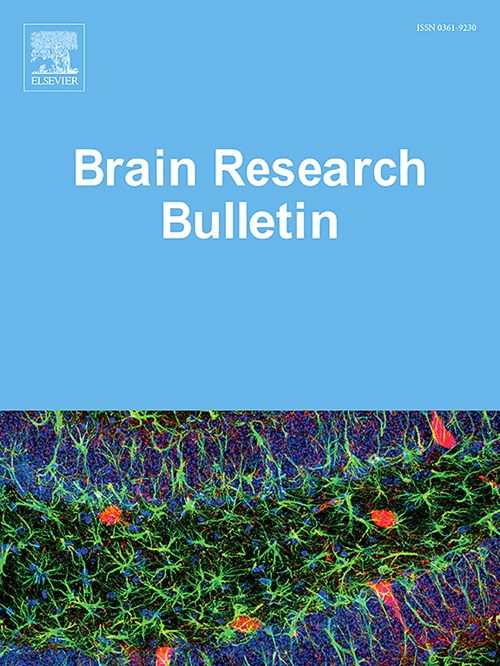METTL3-YTHDF1轴驱动BCL-3 m6A甲基化,促进脑出血时脑微血管内皮细胞铁凋亡
IF 3.5
3区 医学
Q2 NEUROSCIENCES
引用次数: 0
摘要
脑出血(ICH)显著影响人类健康,新出现的证据表明n6 -甲基腺苷(m6A)修饰在缺血性卒中中起关键的调节作用。然而,潜在的机制在很大程度上仍未被探索。本研究旨在全面分析ICH后m6A异常修饰及其机制意义。通过甲基化RNA免疫沉淀和RNA测序数据分析,发现BCL-3在Sprague-Dawley大鼠ICH模型和对照大鼠中的差异表达,揭示了BCL-3与甲基转移酶样3 (methyltransferase-like 3, METTL3),一种m6A甲基转移酶密切相关。在体外ICH模型中进行METTL3的敲低和过表达,进一步阐明METTL3和BCL-3在细胞凋亡和铁凋亡中的作用。结果表明,METTL3基因敲低可显著降低BCL-3的表达,抑制活性氧的产生,减少细胞凋亡和铁下垂。相反,METTL3过表达则产生相反的效果。BCL-3过表达可减轻METTL3敲低所致的影响。此外,YTHDF1敲低导致的结果与METTL3敲低后观察到的结果相当。体内实验表明,METTL3敲低抑制铁下垂并保护脑组织,而BCL-3过表达加重脑损伤。总之,我们的研究结果表明,BCL-3的表达受METTL3-和ythdf1介导的甲基化调节,促进脑出血后的细胞凋亡和铁凋亡,从而导致神经元损伤。本研究揭示了一种新的参与脑出血病理的表转录组调控途径,并确定了METTL3-YTHDF1-BCL-3轴是减轻脑出血后神经元损伤的有希望的治疗靶点。本文章由计算机程序翻译,如有差异,请以英文原文为准。
METTL3-YTHDF1 axis drives BCL-3 m6A methylation to promote the ferroptosis of brain microvascular endothelial cells during intracerebral hemorrhage
Intracerebral hemorrhage (ICH) significantly impacts human health, with emerging evidence indicating that N6-methyladenosine (m6A) modifications serve a critical regulatory function in ischemic stroke. However, the underlying mechanisms remain largely unexplored. This study sought to comprehensively analyze aberrant m6A modification and its mechanistic implications following ICH. Differential expression of BCL-3 between Sprague-Dawley rat ICH models and control rats was identified through analysis of methylated RNA Immunoprecipitation and RNA sequencing data, revealing a close association with methyltransferase-like 3 (METTL3), an m6A methyltransferase. METTL3 knockdown and overexpression were conducted in an in vitro ICH model to further elucidate the roles of METTL3 and BCL-3 in apoptosis and ferroptosis. The results indicated that METTL3 knockdown significantly reduced BCL-3 expression, inhibited reactive oxygen species production, and decreased apoptosis and ferroptosis. Conversely, METTL3 overexpression resulted in the opposite effects. BCL-3 overexpression mitigated the effects induced by METTL3 knockdown. Moreover, YTHDF1 knockdown resulted in outcomes comparable to those observed following METTL3 knockdown. In vivo experiments demonstrated that METTL3 knockdown inhibited ferroptosis and protected brain tissue, whereas BCL-3 overexpression exacerbated brain damage. In conclusion, our findings suggest that BCL-3 expression, regulated by METTL3- and YTHDF1-mediated methylation, promotes apoptosis and ferroptosis following ICH, thereby contributing to neuronal injury. This study reveals a novel epitranscriptomic regulatory pathway involved in ICH pathology and identifies the METTL3-YTHDF1-BCL-3 axis as a promising therapeutic target for mitigating neuronal damage post-ICH.
求助全文
通过发布文献求助,成功后即可免费获取论文全文。
去求助
来源期刊

Brain Research Bulletin
医学-神经科学
CiteScore
6.90
自引率
2.60%
发文量
253
审稿时长
67 days
期刊介绍:
The Brain Research Bulletin (BRB) aims to publish novel work that advances our knowledge of molecular and cellular mechanisms that underlie neural network properties associated with behavior, cognition and other brain functions during neurodevelopment and in the adult. Although clinical research is out of the Journal''s scope, the BRB also aims to publish translation research that provides insight into biological mechanisms and processes associated with neurodegeneration mechanisms, neurological diseases and neuropsychiatric disorders. The Journal is especially interested in research using novel methodologies, such as optogenetics, multielectrode array recordings and life imaging in wild-type and genetically-modified animal models, with the goal to advance our understanding of how neurons, glia and networks function in vivo.
 求助内容:
求助内容: 应助结果提醒方式:
应助结果提醒方式:


